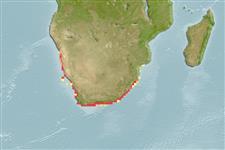Common names from other countries
Environment: milieu / climate zone / depth range / distribution range
Ekologi
laut; payau dasar (demersal); kisaran kedalaman 1 - 80 m (Ref. 3507). Subtropical; 22°S - 35°S
Western Indian Ocean: Natal to the Cape in South Africa.
Length at first maturity / Size / Weight / umur
Maturity: Lm ?, range 53 - ? cm
Max length : 150 cm TL jantan/; (Ref. 3507); Berat maksimum terpublikasi: 34.4 kg (Ref. 40637)
deskripsi pendek
Kunci identifiaksi (pengenalan) | Morfologi | Morfometrik
Duri punggung (Keseluruhan (total)) : 12; duri punggung lunak (Keseluruhan (total)) : 10; Duri dubur: 3; Sirip dubur lunak: 8. Adults with a large fleshy 'nose'.
Inhabits shallow, rocky coastal areas to 80 m depth. Rarely enters estuaries. Feeds on crabs, crayfish, sea urchins and other hard-shelled animals (Ref. 3670). Takes almost any bait (Ref. 3198). Important food fish. Head considered a delicacy in some areas (Ref. 3198). It is parasitised by the monogenean Anoplodiscus cirrusspiralis on the fins and body surface (Ref. 124057).
Life cycle and mating behavior
Maturities | Reproduksi, perkembang biakan | Spawnings | Egg(s) | Fecundities | Larva
Bauchot, M.-L. and M.M. Smith, 1984. Sparidae. In W. Fischer and G. Bianchi (eds.) FAO species identification sheets for fishery purposes. Western Indian Ocean (Fishing Area 51). volume 4. [var. pag.] FAO, Rome. (Ref. 3507)
Status IUCN Red List (Ref. 130435)
CITES (Ref. 128078)
Not Evaluated
ancaman kepada manusia
Harmless
penggunaan manusia
Perikanan: komersial; Ikan buruan: ya
Alat, peralatan
laporan khas
muat turun XML
Sumber internet
Estimates based on models
Preferred temperature (Ref.
115969): 16.7 - 26, mean 23.9 (based on 36 cells).
Phylogenetic diversity index (Ref.
82804): PD
50 = 1.0000 [Uniqueness, from 0.5 = low to 2.0 = high].
Bayesian length-weight: a=0.01549 (0.00846 - 0.02836), b=3.06 (2.91 - 3.21), in cm Total Length, based on LWR estimates for this species & (Sub)family-body (Ref.
93245).
Trophic level (Ref.
69278): 3.6 ±0.40 se; based on food items.
Daya lenting (Ref.
120179): sangat rendah, Waktu penggandaan populasi minimum lebih dari 14 tahun (K=0.05; tmax=45).
Fishing Vulnerability (Ref.
59153): High to very high vulnerability (74 of 100).
